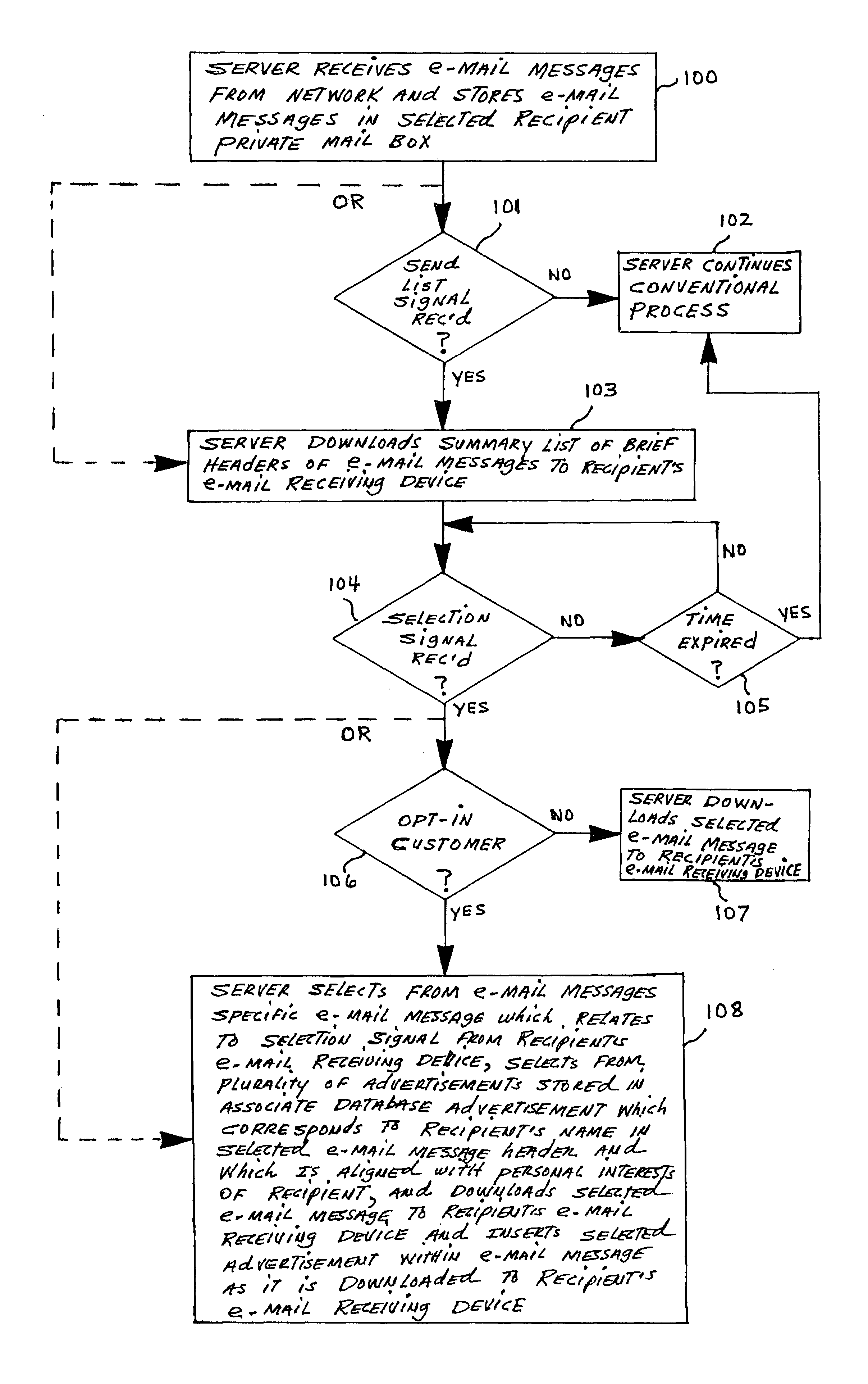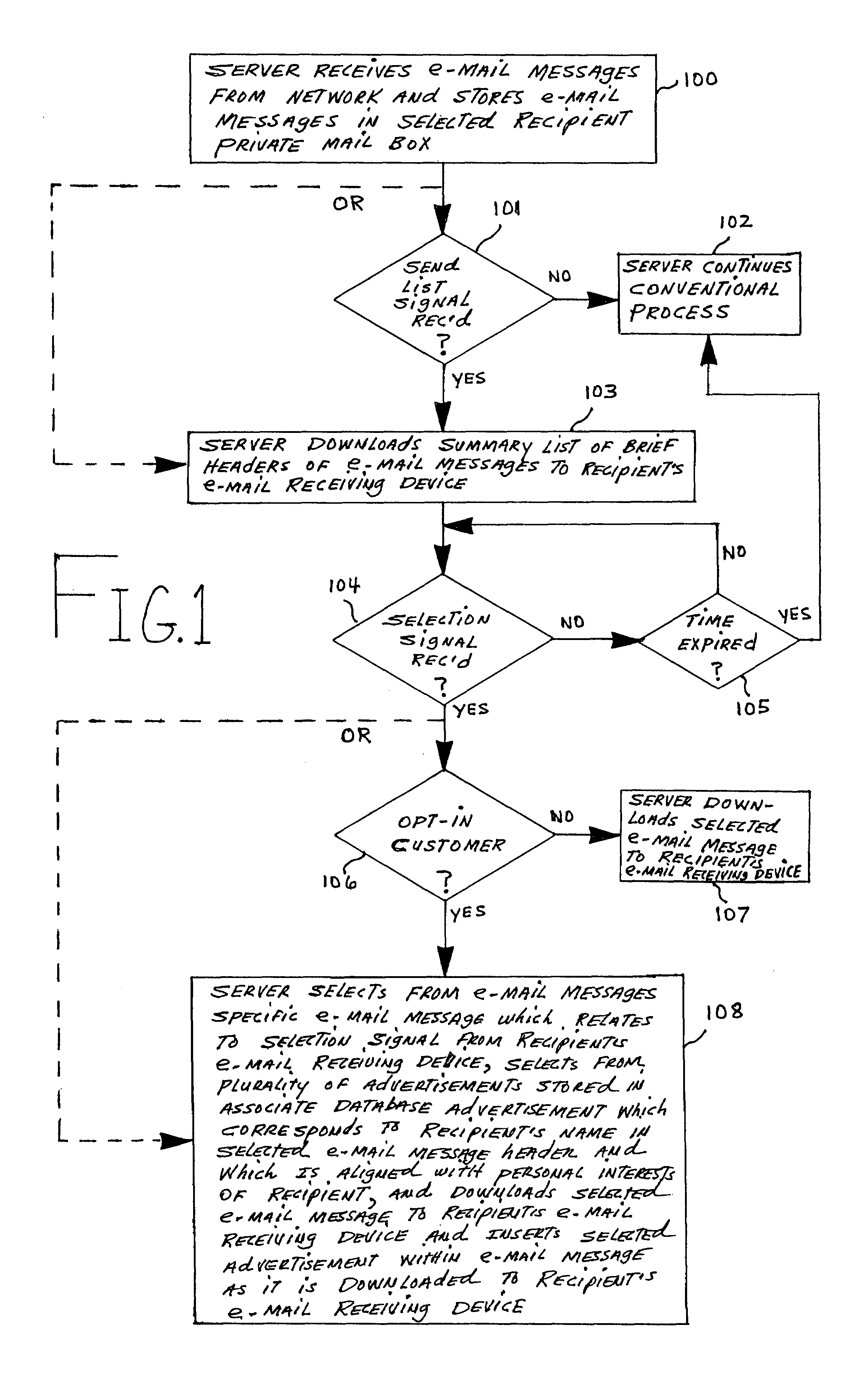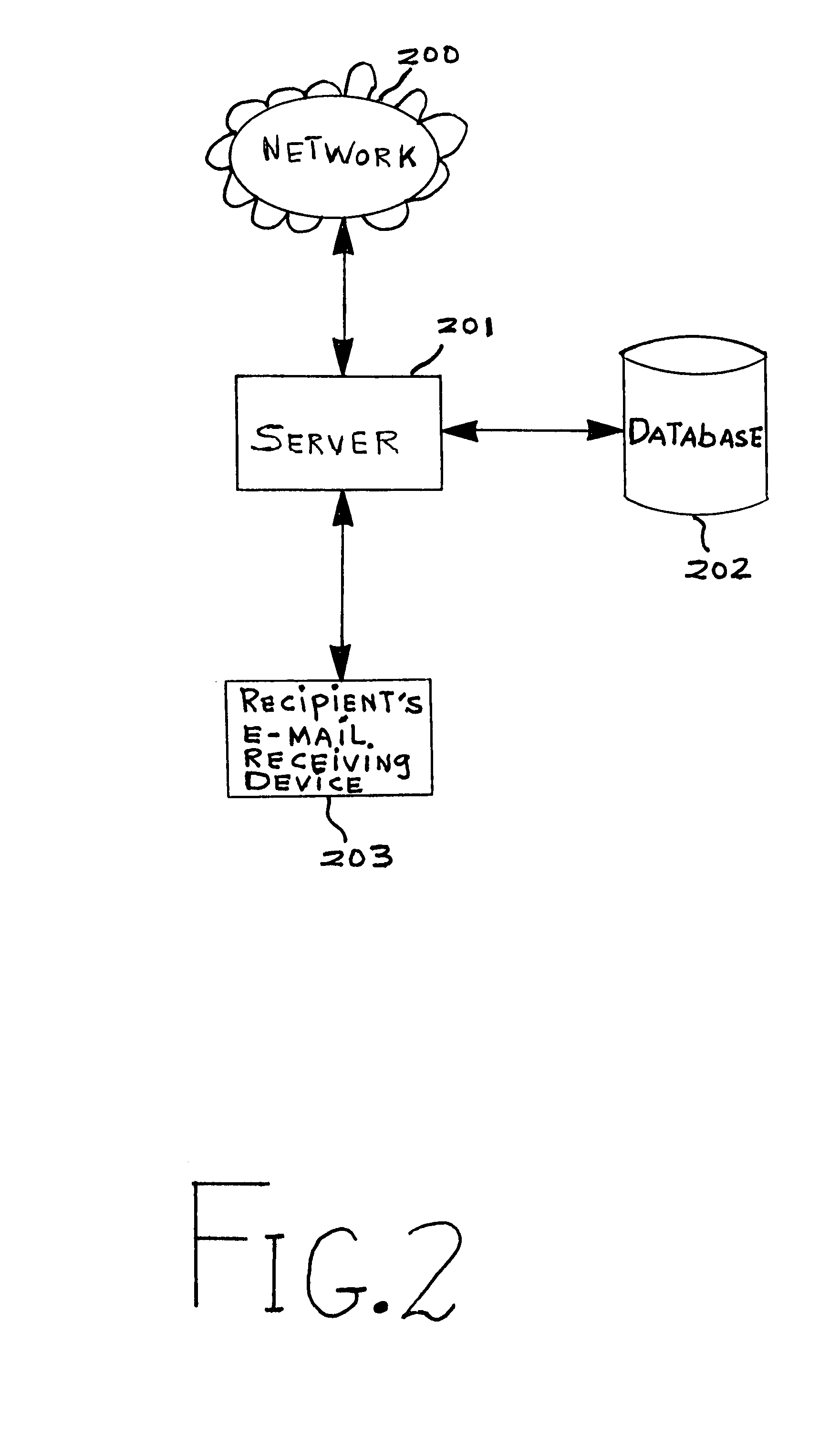[0020]The general organization, of an e-mail system employing the invention is illustrated in the block diagram of FIG. 2 which shows the network 200, which is connected at least periodically to the Internet or Wide Area Network (not shown), the server 201, the database 202, and the recipient's e-mail receiving device 203. By way of example, the sever 201 can be of the type disclosed in U.S. Pat. No. 5,944,786 to Quinn of Aug. 31, 1999, in U.S. Pat. No. 5,905,777 to Foladare et al. of May 18, 1999, in U.S. Pat. No. 5,995,597 to Woltz et al. of Nov. 30, 1999, in U.S. Pat. No. 5,956,486 to Hickman et al. of Sep. 21, 1999, as well as in a book entitled “A Guide to the TCP / IP Protocol Suite”, 1998, 2nd Edition, by Floyd Wilder, ISBN 0-89006-976-X, and in a book entitled “Internet E-Mail, Protocols, Standards . . . ”, by Lawrence Hughes, ISBN 0-89006-939-5. These citations and books are incorporated by reference herein and may be referred to for a more comprehensive understanding of the construction and operation of the e-mail system, but a brief description will be given herein to illustrate how the invention functions within an e-mail system.
[0021]The server 201 is controlled by a control program shown in FIG. 1 and other miscellaneous programs which have not been shown to simplify the drawing. The programs are composed of executable instructions which, when executed by a processor (not shown) of the server 201, carry out the functions performed by the server 201.
[0022]The server 201 (step 100 of FIG. 1) receives transmitted e-mail messages over the network 200 and stores the received e-mail messages in a recipient's private mail box (not shown) associated with the server 201, as described in the aforementioned citations and books incorporated by reference herein. The received e-mail messages show fields for the destination address, the sender's ID, the title of the e-mail messages, and the e-mail messages ID. As previously stated herein, the server 201 is controlled by the control program shown in FIG. 1. For example, in response to a send list signal from a recipient's e-mail receiving device, as shown in step 101 of FIG. 1, indicating that the recipient wishes to view a summary list of brief headers of the e-mail messages stored in the recipient's private mail box, (step 103 of FIG. 1) the processor (not shown) of the server 201, under the control of the control program shown in FIG. 1, downloads (transfers) to the recipient's e-mail receiving device 203 for viewing the summary list of brief headers of the stored e-mail messages, as described in the citations and books incorporated by reference herein. In the alternative, as described in U.S. Pat. No. 5,905,777 to Foladare of May 18, 1999, (steps 100 and 103 of FIG. 1) the server 201 alerts the recipient to a newly arrived e-mail message by automatically downloading the newly arrived e-mail message to the recipient's e-mail receiving device 203.
[0023]In accordance with the present invention, (step 104 of FIG. 1) the processor (not shown) of the server 201, under the control of the control program shown in FIG. 1, determines whether a selection signal has been received from the recipient's e-mail receiving device 203 indicating that the recipient wishes to select from the e-mail messages stored in the private mail box a specific e-mail message to read. If it is determined that a selection signal has been received, (step 106 of FIG. 1) the processor of the server 201 determines whether the recipient is an opt-in customer who is obligated to receive e-mail messages with inserted advertisements. If it is determined that the recipient is, indeed, an opt-in customer, (step 108 of FIG. 1) the processor (not shown) of the server 201 selects from the e-mail messages stored in the recipient's private mail box (not shown) an e-mail message which is related to the selection signal received from the recipient's e-mail receiving device 203, selects from a plurality of advertisements (not shown) stored in an associate database 202 an advertisement which corresponds to the recipient's name in the selected e-mail message header and which is relevant to the personal interests of the recipient, and downloads the selected e-mail message to the recipient's e-mail receiving device 203 and introduces the selected advertisement into the selected e-mail message, preferably in the message header or between the message header and body (text), or after the text, as it is downloaded to the recipient's e-mail receiving device 203 for reading, printing, text-to-speech and / or storing. Again, it will be appreciated that the selected advertisement inserted or introduced within or into the selected e-mail message as it is downloaded to the recipient's e-mail receiving device 203 can be pictorial, or it can be pictorial and state, for example, “This e-mail is sponsored by CNN.Com” or “This e-mail sponsored by Wallstjournal.Com”, etc.
[0024]In an alternative mode, (steps 104 and 108 of FIG. 1) the processor (not shown) of the server 201, under the control of the control program shown in FIG. 1, responds to a selection signal from the recipient's e-mail receiving device 203 by selecting from the e-mail messages stored in the recipient's private mail box storage queve a specific e-mail message which relates to the selection signal received from the recipient's e-mail receiving device 203, selecting from a plurality of advertising messages (not shown) stored in an associate database 202 an advertisement which corresponds to the recipient's name in the selected e-mail message header and which is aligned with the personal interests of the recipient, and introducing the selected advertisement into the selected e-mail message while transferring the message to the recipient's e-mail receiving device 203 for reading, printing, text-to-speech and / or storing.
 Login to View More
Login to View More  Login to View More
Login to View More 


